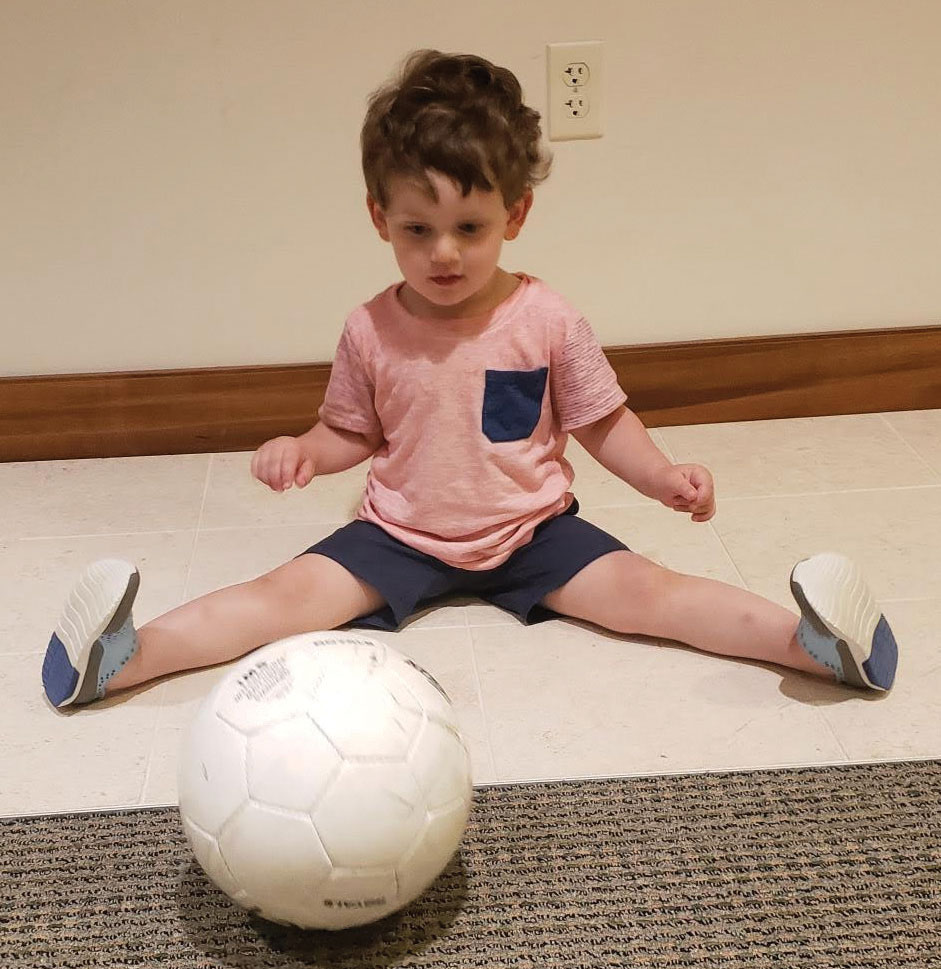 |
Strabismus is a topic that, on the surface, might frighten the faint of heart. Parents report their strabismic children’s eyes turn in or out. They might be seeking a second opinion after an ophthalmologist recommended surgery. They want you to help them understand what is happening and to offer the most appropriate treatment.
While the more common type of strabismus in children is esotropia, exotropia is found in about 20% of young patients with strabismus.1 Parents of children with exotropia often present stating that their child’s eye, or eyes, drifts out. This can happen if the child is looking far away and not concentrating visually, if they are reading at near or in both cases. Exotropia can be intermittent or constant and monocular, alternating or binocular. We look further into it here.
 |
| This child is completing the ball rolling exercise. Click image to enlarge. |
Navigating Treatment
One of the first questions parents of children with strabismus typically have is related to treatment. The second question usually has to do with whether the condition will become constant. Many of us have heard stories about our ophthalmological colleagues telling parents that their child must have surgery. But, thanks to the Pediatric Eye Disease Investigator Group, we can now confidently refute that advice.2 The study observed 183 children ages three to 10 for three years and found that only 15%—which they contend was actually an overestimation—deteriorated.2 Deterioration was defined as having a constant exotropia ≥10 prism diopters (PD) at distance and near or a decreased stereopsis of ≥20.6 log arcsec (tested with Randot Preschool Near Stereoacuity).2 The team also found that exotropia control, stereopsis and magnitude of the exodeviation at distance improved.2
The overall treatment goal for intermittent exotropia is to reduce the frequency and size of the turn to enhance fusion. While surgery is a potential treatment option, others include stimulating convergence with lenses (over-minus), prism therapy (full or partial), occlusion and vision therapy. A study found the following success rates:3
- surgery (with functional results included): 43%
- occlusion: 37%
- over-minus: 28%
- prism therapy: 28%
- vision therapy: 59%
Even though traditional vision therapy offers the greatest chance of success, to say it is challenging in a younger patient population is an understatement, which is why we surmise it is not always the first-line treatment. With so many options, it can be difficult to know which is the right one for your patient. Now that we have research proving that the intermittent turn will likely stay that way, we need to consider other treatment options to spur on improvement. Hopefully, this case series offers some guidance.
Break-out Therapy Activities
|
Case #1
A three-year-old male was seen for a follow-up after having been prescribed over-minus at his last visit several months prior. At both visits (previously without, and at this visit with, spectacles), he showed a 40 PD intermittent alternating exotropia at distance (80% of the time, OD>OS) and orthophoria at near. His mother reported that he refused to wear the glasses, and when he did wear them, he looked over them. His visual acuities were 20/30 OU with the glasses and 20/20 OU without them. He showed gross stereopsis with the Keystone Basic Binocular (KBB) test at near. Even though the turn was occurring only at distance, we attempted prism to see if there were any changes and observed none.
Given that the child refused to wear the over-minus lenses and prism was ineffective, we instituted a modified home vision therapy program of basic bilateral eye movements. The key in this case was to encourage convergence-type movements. With this in mind, we instructed the parent to roll a ball (large at first) to the child from several feet away and play a balloon hitting game. Horizontal and vertical eye stretches, in which the child tracks the moving object back and forth and up and down several times, were instituted.
We will see the child in several months to evaluate his progress. As he gets older, we will consider a full round of therapy.
Case #2
A three-year-old female was seen for a second opinion after surgery was recommended. Her uncorrected acuities were 20/25 OD, 20/30 OS and 20/25 OU, and the cover test showed an 18 PD intermittent right exotropia 50% of the time at distance and 4 exophoria at near. Stereopsis was positive using the KBB, as the child localized several pictures. Retinoscopy showed plano -1.00x180 OU. An over-minus of -1.50 D was provided on top of the astigmatism correction, but the acuities dropped to 20/80 OU. We then moved on to try prism using a 3 PD base-in in each eye and found a modicum of success. The cover test now showed 10 exophoria at distance and orthophoria at near.
We prescribed the astigmatism along with the prism for full-time wear and requested basic eye stretches. She will be re-evaluated in two to three months.
Case #3
A 15-year-old male presented for his yearly exam. Wearing -6.00 D OU, his acuities were 20/80 OU. The cover test showed 25 intermittent alternating exotropia at distance and near. Global stereopsis was absent. He was refracted and, with -7.50D OU (20/20 OU), showed 20 intermittent alternating exotropia at distance and 15 exophoria at near.
Our next treatment option was prism. With a 3 PD base-in in each eye, the cover test showed 10 exophoria at distance and near. KBB was retested, and a positive response was recorded. He will be reevaluated in two to three months.
As discussed earlier, the purpose of treatment for intermittent exotropia is to provide the opportunity for fusion. In two of the case examples, we used over-minus without success, but that should not deter you from trying it with your own patients. With the second patient, the acuity actually decreased with the extra minus—not the expected outcome—and we were forced to try another treatment option. In all three cases, we employed the use of prism, and in two cases, we found success.
There is no magic amount of prism that will work with each patient. We recommend starting with about one-third of the amount of the eye turn and rechecking the cover test. Consider adjusting to find the most appropriate amount of prism at this time. Each of the two successful prism cases showed about 20 to 25 PD, so we selected a 3 PD base-in OU. In two of the cases, we instituted some basic therapy. In the first, it was the sole treatment, while it was adjunctive to the prism in the second. Anything that we can do to spur on looking and convergence behavior will set the stage for a full program of vision therapy.
There is no rush to jump into the deep end and recommend surgery as a first-line treatment for strabismus, and, more specifically, for exotropia. The three treatment options discussed should be considered as alternatives before pursuing a more aggressive pathway.
1. Rutstein RP, Daum KM. Anomalies of Binocular Vision: Diagnosis and Management. St. Louis, MO: Mosby, 1998. 2. Mohney BG, Cotter SA, Chandler DL. Three-year observation of children 3 to 10 years of age with untreated intermittent exotropia. Ophthalmology. January 15, 2019. [Epub ahead of print]. 3. Coffey B, Wick B, Cotter S, et al. Treatment options in intermittent exotropia: a critical appraisal. Optom Vis Sci. 1992;69(5):386-404. |

